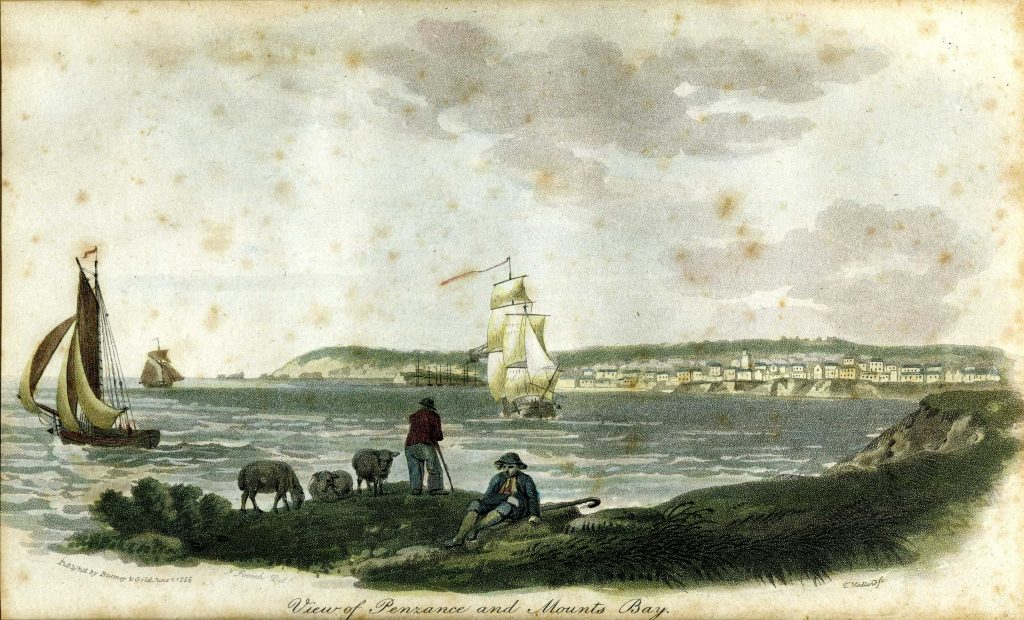The Fairy 1786
6 July 20211792 – A raid on the cove
6 July 2021Early in 1785, Fairy was again in serious risk in Mounts Bay. Between 22nd February and 1st March (virtually the same dates as the previous year) she was again caught at anchor in Gwavas Lake in a serious storm. On an ebbing tide her anchors dragged and with her keel pounding the bottom towards low tide, stores and spars had to be thrown overboard to lighten her. Lieut William Burgess of Newlyn,1 ‘at the hazard of his life’, managed to salvage most of this gear for the Fairy, and she survived the storm. Afterwards Capt Thomas described this weather as the ‘heaviest seas he had ever experienced’. Fortunately for him, despite her pounding, the vessel was not materially damaged.2
Intriguingly Scobell, the Collector of Customs at Penzance, in his monthly return – of the Arrival, and Sailing of the Ships, Cutters &ca. in His Majesty’s Naval Service employed, for the Suppression of Smuggling which have Entered into this Port, in the Month of Feby 1785, only records the Fairy as arrived within port limits on February 22nd, and sailing again on February 25th … looking after the Smugglers.’ 3 Whereas the Fairy’s log tells otherwise.
April and May 1785 are particularly successful, and Captain Thomas must have been chuffed when he took the Glory of Cawsand, from Guernsey with 500 ankers of spirits on board for trading.4
5th June – ‘Sunday in Carrick Roads Light breeze with rain. 1 p.m. celebrated the King‘s Birthday with a 21 gun salute.‘
And, on the 29th – ‘ … went by order of Capt Bryson for Intelligence to Guernsey.’
In June a series of seizures were delivered to Falmouth. On 21st July they ‘spoke a Danish East lndiaman from Bengal‘, and on 24th ‘spoke a Calcutta East lndiaman‘.
2nd August – ‘Gave chase … proved to be Dolphin Revenue Cutter of St Ives‘.
At this point the Falmouth Customs commenced an apparent vendetta against Captain Thomas. It must have been unheard of that the Customs should board an HM vessel on Revenue duties to search for contraband foreign spirits, but this is what they did on 2nd September. They searched in vain, but it was nothing less than a calculated insult. Two days later one of the Falmouth Customs Officers accused the Master of the Fairy of bringing illicit spirits onshore. This was strenuously denied, but the Customs seized the Fairy‘s boat at Flushing. Nothing was found in her, and in a letter to Admiralty, dated 23rd October, Captain Thomas complains that the Falmouth Customs have confiscated the Fairy’s boat, and that when the Master and the Purser went ashore they had a few ‘private’ bottles of wine, which were seized from them at the door of their homes in Flushing. Capt Thomas further accuses the Customs of swearing a ‘malicious affidavit’. The matter was finally settled and the Customs were to return the boat.
On September 25th, Fairy is in company with HM frigate Druid off Start Point, when they give chase to a strange sail which proves to be yet another revenue cutter. Then, on the 3rd October her top mast carried away, damaging the Main top, so she had to put into Falmouth once again to effect repairs .
Their running feud with the Falmouth Customs officers was resumed when the Fairy seized a Venetian ship with 280 anchors of spirits, put an armed prize crew of 14 hands on board, and sent her into Falmouth. This incident blew up into a major complaint by Capt Thomas against the Customs in Falmouth. Having carried her in the Fairy’s men were not relieved by guards from Falmouth Customs as was customary, and for security reasons they were compelled to remain on board to guard the prisoners, leaving the Fairy short handed. Thus she was unable to continue her patrol and to carry out her duties – all of which Capt Thomas had to explain to the Lords of the Admiralty.5

From the very first, Captain Thomas had taken particular care about his introduction to Falmouth Customs. He had also taken his Number One Lieut Henry Spriddle, and Lieut Swann of Sprightly, along to Falmouth Customs house for a mutual introduction, and to present his instructions from the Admiralty.6
One factor which might have riled the Customs was that the Royal Naval vessels seconded to anti-smuggling patrols did not come under the discipline and control of the Customs Service, but a more likely cause was plain jealousy. Effectively the Fairy and Sprightly were acting in competition with the local revenue cruisers – Hawke, Hinde and Lark. Any awards for seizures made by the naval vessels would be kept for distribution amongst the naval crews. And, even though the contraband seized and smuggling vessels taken were handed to the Falmouth Customs, they may not have brought those officers any significant material reward.
Additionally, Captain Thomas being a Tregony/Fal Estuary man, there may have been some local ‘relationships’ behind these incidents, and there were certainly many minor instances where naval officers thought themselves above the law – as the above ‘few private bottles of wine,’ demonstrates.
On 5th December a very heavy southerly gale and swell, caught the Fairy sheltering in Carrick Roads, her anchors dragged and on the 5th the ‘small bower’ was streamed. Despite this, at 1 p.m. on the 7th she grounded at the bottom of the tide, and – ‘we started our beer and water and threw stores overboard and made signals for the pilot’.
She struck ground, probably on the heel of her keel aft, where she had her greatest draft. Fortunately no damage was done to her rudder. A pilot came aboard and the sloop was moved on the rising tide, up into the harbour to a safer and more protected anchorage.
